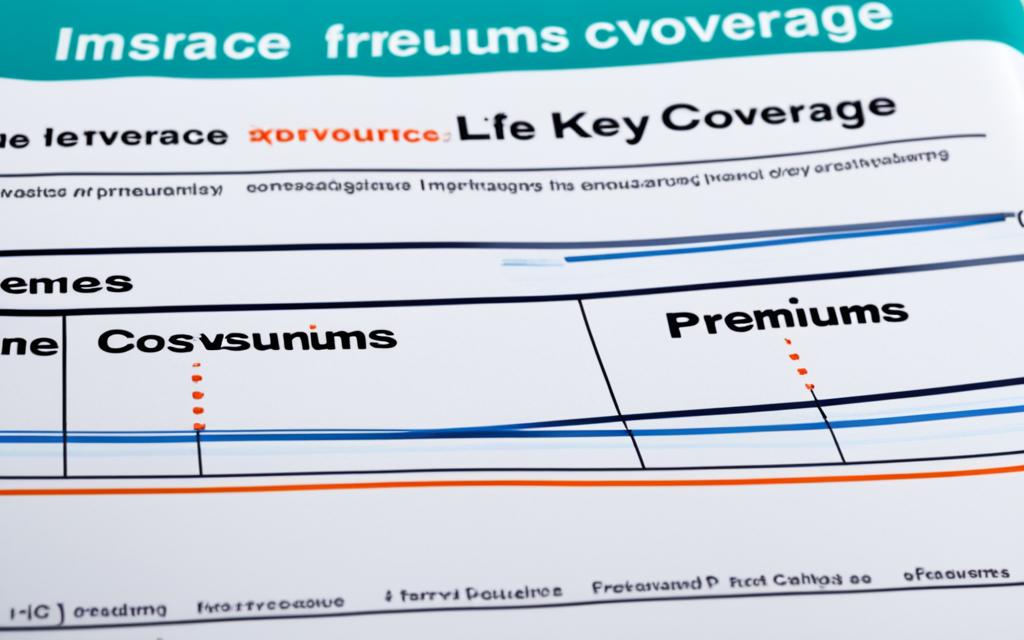Life insurance is a policy you make with an insurance company. You pay premiums over time. Then, your loved ones get a lump sum, called a death benefit, when you die.1 There are two main types: permanent and term.1 Permanent life insurance lasts your whole life. Term life insurance covers you for just a set period.1 Which one you choose depends on your money needs and plans. This guide will help you understand life insurance better. It covers everything from the types of policies to how to apply and make claims.
Key Takeaways
- Life insurance comes in two main types: permanent and term.
- Premiums are influenced by factors like age, lifestyle, and health.
- Permanent policies provide lifetime coverage, while term policies cover a specific period.
- Riders can offer additional benefits, like converting a term policy to permanent.
- Younger, healthier individuals typically pay lower premiums.
What is Life Insurance?
Definition and Purpose
Life insurance is a contract between you and an insurance company.2 You pay premiums, and in return, they promise a death benefit. This is a sum given to your loved ones if something happens to you. Its main aim is to offer financial security to those you leave behind.
Life Insurance Contract
This contract has details on payments and benefits.2 You make regular payments to keep your policy current. Beneficiaries get a one-time payment when you pass away.
Premiums and Death Benefits
2 Life insurance pays out when you die, but health insurance helps with medical bills during life. You might have a share of costs like copayments with health insurance. People usually buy life insurance to safeguard their family’s future. Health insurance, on the other hand, is crucial if you lack employer or government coverage.
Types of Life Insurance Policies
Life insurance comes in two main types: term and permanent.3 Term life insurance lasts for a set time. This could be anywhere from 10 to 30 years. If the person dies within this time, their loved ones get a payment.45 On the other hand, permanent life insurance covers the person for their whole life, as long as they keep paying.
Term Life Insurance
Term life insurance is the most affordable option. It focuses on providing a death benefit without saving money over time.3 You can choose a policy that lasts 10, 15, 20, or 30 years.5 The death benefit can be very large, which helps protect your family’s finances.5
Permanent Life Insurance
Permanent life insurance, like whole and universal, covers you for life as long as you keep up with premiums.45 Whole life has set premiums and benefits. Universal life lets you change premiums and benefits within certain limits.4
Whole Life Insurance
Whole life insurance is more expensive than term because it has a savings component.3 It offers lifelong coverage with a constant benefit and premium.34 Both the death payment and premiums stay the same.
Universal Life Insurance
Universal life plans last a lifetime and allow you to change your rates within certain bounds.5 They might be cheaper than whole life, but they’re less secure.3 You can adjust how much you pay and how much your loved ones get.3
Variable Universal Life Insurance
Variable universal life mixes elements of variable life and universal life.5 Premiums in variable life plans don’t change, and the payout is certain, no matter how investments do.5

To pick the right life insurance, it’s important to understand the difference between term and permanent. Also, be aware of the different types available in each category to meet your financial and life protection goals.
Life Insurance Basics
Life insurance is key for financial security, protecting your loved ones. It’s important to know the basics. These include types of policies, premiums, and benefits.6
Life insurance is important for those with young families. It helps them financially if the provider dies. It also pays for final expenses like funerals. Plus, it can support your children’s future and cover taxes.6
Some policies also work as a savings account. You can borrow from them if needed. There’s term and permanent life insurance. Term pays if death happens within a set time. Permanent is for life with cash value.6
Whole life stays the same over time and has a cash value. Universal life is more flexible and earns interest. Variable life lets you invest but has more risk.6
Knowing the life insurance basics is vital. It helps pick the right plan for you. Learn about different policies and their benefits. This knowledge will guide your choices.6
Key Factors Affecting Premiums
The price of life insurance premiums depends on several main factors. These include how old you are, whether you’re a man or a woman, your health, and what you do for a living. Knowing these facts can guide your choice when picking the right life insurance plan for you.
Age
Usually, younger folks pay less for life insurance. That’s because they are less likely to die soon. As you get older, life insurance costs more, about 8% to 10% with each passing year.7
Gender
Your gender affects the cost of life insurance too. Since women tend to live longer, they pay less for coverage.7 This is because insurance companies see them as less risky, so they charge lower premiums to women.
Health and Medical History
Your health and medical background are huge in figuring premium costs. If you’ve had health issues, insurers see you as more of a risk. This leads to higher prices.8
Family health history matters, too. If your family has a lot of serious illnesses, your premiums could go up. This reflects the increased risk for insurance companies.7
Lifestyle and Occupation
What you do and how you live also play a big role in your insurance cost. If you smoke, your premiums can be over double those of non-smokers. This is because smoking is linked to many health problems.7
Hobbies or jobs that are risky, like racing cars or police work, also mean higher premiums.7 Your driving record affects the price too, especially the last three to five years.7
To get the best life insurance for you, it’s crucial to understand these factors well. They can guide you to a plan that meets your needs and budget.

Choosing the Right Coverage
Choosing the right life insurance is about looking at your needs and what you can afford. Think about your salary, what you owe, your family, and future money plans.9
Assessing Your Needs
You must decide if term or permanent life insurance fits better, because they vary a lot in coverage and costs.9 Term life is great for those who just need coverage now, like for their kids’ college fund, for 20 years.9 While, permanent life suits those who want coverage forever.9
Term vs. Permanent Life Insurance
Term life has cheaper rates for every thousand dollars in coverage than permanent life.9 But, the cost of term insurance goes up when you renew, especially as you get older.9 Permanent life insurance, like whole life, is more expensive, but your rate stays the same no matter your age9.
Riders and Additional Coverage
Permanent life, including whole, universal, and variable, offers different benefits. You can also add riders to your policy for extra protection, like if you get sick or need long-term care.9
Application and Underwriting Process
When you apply for life insurance, you provide personal and medical info to the company. This includes your age, gender, health history, and lifestyle.10 They check this info to see if you can get coverage, how much you can get, and how much it’ll cost.
Required Information
It’s easy to apply online, usually taking just a few minutes.10 Actuaries use mortality stats to help underwriters make decisions. They want to make sure the coverage you get fits your needs.10 During the underwriting process, they might ask for a Proposal Form, Age Proof, and Income Documents. Also, expect to fill out Questionnaires, see a Sales Report, and have a Client Confidential Report.
Medical Exams
Most policies will need you to have a medical exam. A health professional will measure things like your blood pressure and cholesterol. They’ll also ask about your medical past.11 Underwriters use this info to judge how risky it is to insure you, based on health issues.10 They will double-check your application to make sure everything is right. You might also have to do some medical tests, like blood checks and drug tests, to look at any health risks closely.10
Risk Assessment
The company looks at all the info to guess your risk level. Then, they decide the right coverage and how much you should pay.11 Underwriting gets into every detail of your health and finances to figure out how risky you are. They might look at your medical and credit history, plus do background checks, to see if you’re insurable.11
There are different rating levels, like Preferred Plus and Substandard. Your premium might go up if your job or hobbies are high-risk. Smoking or certain health issues could also raise your premium compared to others.11
They check a lot of data to figure out how long you might live and which category you fall into. This can range from those in great health to those with more risks11. If you’re in the high-risk group, you might pay more in premium.
The underwriting process is key in getting you the right coverage at a good price. It helps insurance companies pick out the risks they’re willing to take.10 This keeps their predictions close to actual results. So, they can offer better prices to everyone.
Getting through underwriting can take anywhere from three to eight weeks. But, some companies provide quick decisions if you’re eligible for fast-track underwriting.11 The use of artificial intelligence is making this process faster. Big companies like Nationwide are now using AI to speed things up.
Your premium is based on several things, like your age, health, and job. But, when choosing a life insurance, don’t just look for low premiums. Think about the benefits and how easy it is to make a claim, too.10

Beneficiaries and Claims
With life insurance beneficiaries, you can choose whom the money goes to after you’re gone12. You pick one main person, and if they can’t get the money, then it goes to someone else you name, known as the contingent beneficiary12. You can pick your spouse, parents, siblings, adult children, or others like business partners, charities, or a trust. But remember, you can’t choose minor children as beneficiaries13.
Claiming life insurance benefits is pretty easy for those who are entitled. Once you submit a claim, you can usually expect the money between 30 to 60 days13. The insurance company has a month to look over your claim. After that, they can decide to pay, say no, or ask for more info13. If the policy is less than two years old when the insured passes, it can take longer. In this case, payment might be delayed by six to 12 months because of extra checks13.
Getting life insurance benefits usually means a tax-free check for the beneficiaries. But, in some cases, there might be taxes to pay based on the policy and how the beneficiary is connected to the one who took out the policy. This tax-free benefit can help cover federal and state tax bills, which can save the inheritors from having to sell off other parts of the deceased’s estate6.
Shopping for Life Insurance
When looking for life insurance, it’s key to compare quotes from many providers. This helps you find the best deal on coverage.14 Be sure to look at premium costs, coverage amounts, and the type of policy. Also, check the financial strength of the insurance company.14
Comparing Quotes
To choose the best life insurance for you, get quotes from several top companies.14 Comparing these quotes will show you the differences in what’s offered. Focus on premiums, coverage limits, and policy features to make a good choice.14
Top-Rated Life Insurance Companies
In the U.S., top life insurance companies like Nationwide and Protective are highly rated.14 Others include MassMutual, Mutual of Omaha, and Guardian. USAA and New York Life are also among the best.14 They have different life insurance options to meet your needs.14

Conclusion
Life insurance is very important for you and your family. It helps to keep them safe and secure. By knowing the basics, you can choose the best plan for your needs.1516
Don’t forget to check your policy often. Make sure it still fits your goals and needs.15 With a good life insurance, your family’s future is protected.1716
Understanding life insurance may look hard. But, knowing your choices and working with a good provider makes it easier. It can give you and your family a big financial safety net.1516
FAQ
What is life insurance?
What are the main types of life insurance policies?
What factors affect the cost of life insurance premiums?
How do I determine the right life insurance coverage for my needs?
What is the life insurance application and underwriting process?
How do I name beneficiaries and file a claim on a life insurance policy?
How can I compare life insurance quotes and find the best coverage?
Source Links
- https://www.bankrate.com/insurance/life-insurance/life-insurance-guide/
- https://www.ehealthinsurance.com/resources/affordable-care-act/life-insurance-basics
- https://www.forbes.com/advisor/life-insurance/types/
- https://www.iii.org/article/what-are-principal-types-life-insurance
- https://www.nerdwallet.com/article/insurance/types-of-life-insurance
- https://www.iii.org/article/life-insurance-basics
- https://www.investopedia.com/articles/investing/102914/7-factors-affect-your-life-insurance-quote.asp
- https://www.forbes.com/advisor/life-insurance/factors-affecting-rates/
- https://www.iii.org/article/how-choose-right-type-life-insurance
- https://www.canarahsbclife.com/blog/life-insurance/what-is-life-insurance-underwriting-process
- https://www.bankrate.com/insurance/life-insurance/underwriting/
- https://www.securian.com/insights-tools/articles/naming-a-life-insurance-beneficiary.html
- https://www.investopedia.com/articles/personal-finance/121914/life-insurance-policies-how-payouts-work.asp
- https://www.investopedia.com/terms/l/lifeinsurance.asp
- https://unacademy.com/content/upsc/study-material/general-awareness/a-brief-note-on-life-insurance/
- https://www.nerdwallet.com/article/insurance/how-does-life-insurance-work
- https://blog.massmutual.com/insurance/life-insurance-ultimate-guide
